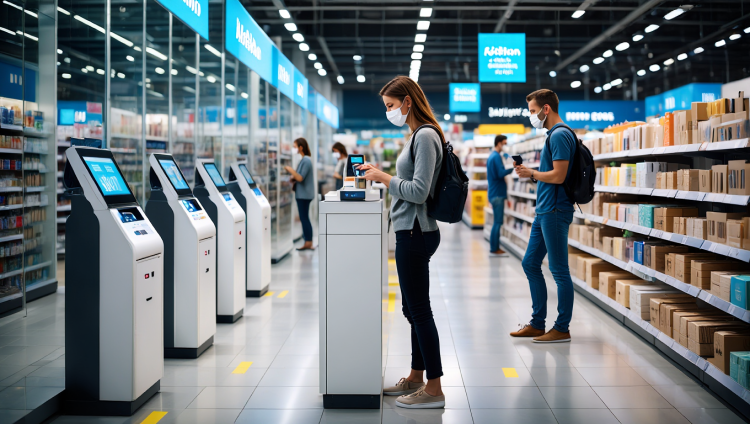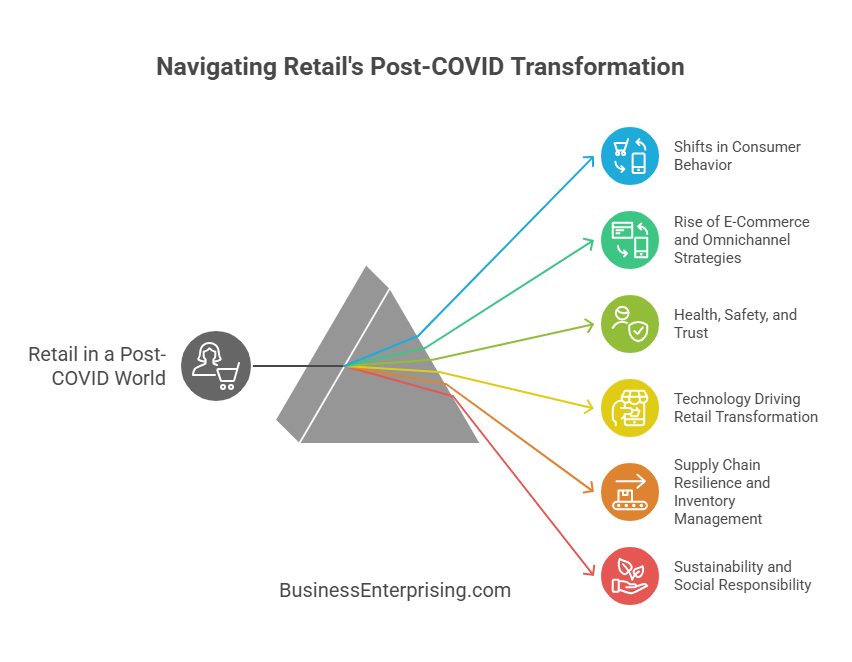
Additionally, the way you value convenience has shifted. You want flexible options that combine both digital and physical experiences. Therefore, retailers have invested in e-commerce, contactless payments, and curbside pickup. Moreover, they have adapted their physical spaces to focus on safety, trust, and efficiency. These adjustments are not temporary but part of a permanent shift in how you interact with brands.
Consumer values have also become more focused on responsibility. You want companies to show transparency in sourcing, sustainability, and community involvement. Therefore, many businesses highlight their ethical practices to build loyalty. Additionally, you reward retailers that demonstrate accountability through long-term support and repeat purchases. Trust has become central to your choices, and businesses continue to respond.
Technology has further accelerated the transformation. You now rely on digital tools to discover, compare, and purchase products with ease. Therefore, personalization powered by data plays a larger role in your shopping experience. Additionally, supply chain resilience has become important to ensure product availability. These elements together define the direction of modern retail.
The future of retail reflects both your needs and the lessons businesses learned. Therefore, adapting to these shifts is essential for ongoing growth. Additionally, keeping you at the center of every decision allows retailers to succeed in an environment shaped by lasting change.
Shifts in Consumer Behavior After COVID
Consumer behavior shifted dramatically during the pandemic and those changes continue to shape retail in a post COVID world. You saw priorities shift toward convenience, value, and safety. Many of these expectations remain, influencing how you shop and what you demand from businesses.
Additionally, the reliance on digital channels increased. You turned to online shopping not only for products but also for services. Therefore, businesses had to expand e-commerce and improve customer experiences across digital platforms. Moreover, hybrid models like curbside pickup and home delivery became standard. You now expect these options to remain available and efficient.
Health and safety measures also altered shopping habits. You became more selective about where and how you shop. Therefore, visible sanitation practices, contactless payments, and store layouts that reduce crowding gained importance. Additionally, businesses that adopted these practices earned greater trust. Many of these standards continue to affect your decision-making.
Another lasting change is value-driven spending. During uncertain times, you redefined what mattered most. Therefore, affordable prices, flexible return policies, and reliable customer service became higher priorities. Additionally, brand loyalty weakened as you explored alternatives that offered greater value. This trend remains influential for businesses seeking to retain customers.
Sustainability and social responsibility also rose in importance. You increasingly favor companies that align with your values. Therefore, businesses are expected to communicate their commitments clearly and consistently. Additionally, brands that show authenticity in these areas win more support.
Consumer expectations have evolved, and businesses must continue adapting. Therefore, understanding these shifts helps you recognize what drives retail decisions now and in the future.
The Rise of E-Commerce and Omnichannel Strategies
E-commerce grew at an unprecedented pace during the pandemic, and the momentum has continued. Retail in a post COVID world reflects this shift, with online channels now central to how you shop. You expect convenience, speed, and choice, which makes digital platforms essential for every retailer.
Additionally, the demand for seamless experiences across channels has expanded. You no longer view online and offline as separate options. Therefore, businesses have adopted omnichannel strategies that combine both. Moreover, you want the flexibility to browse online, purchase in-store, or arrange pickup and delivery. This integration keeps your shopping experience simple and consistent.
Retailers now recognize that digital tools influence nearly every sale. Therefore, investments in mobile apps, online stores, and digital support have increased. Additionally, in-store experiences now blend with technology through options like contactless payments and self-service kiosks. These integrations create a smoother experience that reflects your expectations for speed and convenience.
However, e-commerce alone does not replace physical retail. Stores remain important for discovery, service, and customer trust. Therefore, the most effective retailers connect both worlds. Additionally, they use data from online behavior to shape in-store experiences. This balance allows businesses to serve you wherever you prefer to shop.
Omnichannel strategies are no longer optional. Therefore, companies that adapt create consistent experiences across all platforms. Additionally, those that invest in both digital and physical touchpoints build loyalty and trust. Your expectations have changed, and retailers must continue to meet them with flexibility and integration.
Health, Safety, and Trust as Ongoing Priorities
Health, safety, and trust remain central to retail in a post COVID world. You continue to expect businesses to prioritize your well-being in physical spaces. Clean environments, visible safety measures, and clear communication still influence where and how you choose to shop.
Additionally, transparency has become a key factor. You want to know how businesses maintain cleanliness and protect customers and staff. Therefore, retailers that share their practices openly build stronger trust with you. Moreover, visible safety steps, like sanitizing stations and organized traffic flow, make you feel more comfortable while shopping.
Trust extends beyond hygiene. You also value honesty in policies related to returns, refunds, and customer service. Therefore, businesses that remain clear and consistent in their communication create loyalty. Additionally, this honesty reduces uncertainty and strengthens your confidence in the brand. With trust, you feel more secure making repeat purchases.
However, safety measures do not only serve as a pandemic response. They now represent a standard for physical retail environments. Therefore, maintaining these practices signals respect for customer needs. Additionally, it demonstrates a commitment to long-term responsibility rather than temporary compliance.
Consumers continue to reward businesses that focus on well-being and clarity. Therefore, prioritizing safety and transparency has lasting benefits. Additionally, it builds stronger customer relationships and supports the long-term reputation of the brand. For you, trust remains an essential factor in choosing where to shop.
Technology Driving Retail Transformation
Technology continues to shape how you experience retail in a post COVID world. Businesses have adopted digital tools that improve convenience and safety. Contactless payments, curbside pickup, and AI-driven personalization are no longer optional but expected. These innovations now define the way you shop.
Additionally, payment technology has become a priority. You prefer quick, secure, and touch-free transactions. Therefore, retailers expanded contactless options that reduce friction during checkout. Moreover, mobile wallets and tap-to-pay features have become standard across many stores. These improvements save you time and make purchases easier.
Curbside pickup has also grown into a permanent service. You value the flexibility of ordering online and collecting items without entering the store. Therefore, businesses redesigned their operations to support this demand. Additionally, curbside options help retailers connect online and offline shopping in ways that match your expectations.
AI-driven personalization has further transformed retail. Algorithms now analyze your preferences to recommend products and promotions. Therefore, you experience more relevant and efficient shopping. Additionally, this personalization improves satisfaction while boosting sales for businesses. With technology, retailers tailor their services to your needs with greater accuracy.
However, adopting technology is not only about convenience. It also builds trust by showing you that businesses listen and adapt. Therefore, companies that invest in digital tools create stronger relationships with their customers. Additionally, they prepare themselves for long-term growth in a changing market. Technology will remain a core driver of retail. Therefore, the ongoing use of digital tools keeps your shopping experience faster, safer, and more personal.
Supply Chain Resilience and Inventory Management
Supply chain resilience has become a major focus for retail in a post COVID world. You saw how shortages and delays disrupted access to goods. Retailers learned that relying on limited sources or rigid systems created serious vulnerabilities. Therefore, building stronger and more flexible supply chains is now a priority.
Additionally, businesses are diversifying suppliers. You benefit when retailers have backup options for sourcing products. Therefore, companies reduce the risk of disruption when one supplier faces challenges. Moreover, many are working with local partners to shorten delivery times and limit exposure to global issues. This approach helps maintain consistent availability for you.
Inventory management has also evolved. Retailers use technology to monitor stock levels in real time. Therefore, they respond more quickly to changes in demand. Additionally, predictive analytics helps companies forecast needs with greater accuracy. As a result, you experience fewer shortages and more reliable access to products.
However, resilience is about more than managing stock. It also includes logistics and distribution. Therefore, businesses are strengthening relationships with carriers and exploring multiple shipping routes. Additionally, they are investing in warehouses that provide more flexible storage. These steps reduce delays and give you a smoother shopping experience.
Retailers understand that transparency matters as well. Therefore, they communicate more openly about availability and shipping times. Additionally, this honesty builds trust and helps you manage expectations. By focusing on resilience, companies are better prepared to serve customers consistently.
Building flexible systems allows retailers to adapt quickly. Therefore, you benefit from a supply chain designed to handle challenges while keeping your needs a priority.
Sustainability and Social Responsibility in Retail
Sustainability and social responsibility have become lasting priorities in retail in a post COVID world. You now place greater value on businesses that consider their impact beyond sales. Companies that focus on ethical sourcing, fair labor, and environmentally responsible practices earn stronger loyalty from you.
Additionally, transparency has become an expectation. You want to know where products come from and how they are produced. Therefore, retailers that provide this information openly gain more trust. Moreover, clear communication about sustainability practices helps you feel connected to brands that align with your values. This connection influences how and where you choose to spend money.
Ethical sourcing also plays a larger role in your decisions. You often prefer products from companies that treat workers fairly and reduce harm to communities. Therefore, many businesses now highlight supplier relationships and sourcing policies. Additionally, they support local producers to strengthen both supply chains and communities. These choices show responsibility that resonates with your expectations.
Community engagement is equally important. Businesses that support local causes or provide resources beyond sales stand out. Therefore, you notice when retailers invest in education, health, or neighborhood programs. Additionally, these actions demonstrate care for more than profit. When you see real commitment, you reward those businesses with loyalty.
Retailers understand that sustainability and responsibility are no longer side notes. Therefore, they integrate them into everyday operations. Additionally, they use these practices to build stronger brands that reflect consumer values. For you, supporting responsible businesses creates confidence that your purchases matter beyond the product itself.
Conclusion
Retail in a post COVID world reflects lasting changes that continue to shape how you shop and what you expect from businesses. The pandemic accelerated shifts in behavior, technology, and trust that remain part of your everyday choices. Therefore, companies must continue adapting to meet your evolving priorities.
Additionally, you now expect convenience, flexibility, and transparency. Retailers that blend online and offline experiences provide the seamless options you value most. Therefore, businesses that invest in omnichannel strategies, safety measures, and responsible practices position themselves for long-term success. Moreover, these efforts strengthen your loyalty while creating stronger connections.
Sustainability and social responsibility also remain central. You increasingly support businesses that reflect your values through ethical sourcing and community engagement. Therefore, retailers that demonstrate authentic commitment gain more trust. Additionally, technology and resilient supply chains continue to drive progress, ensuring products and services remain accessible. These elements define a stronger retail environment for the future.
However, change does not end here. Consumer expectations will continue evolving, and businesses must stay responsive to those shifts. Therefore, retailers who listen to you and adjust their practices build resilience and growth. Additionally, consistent transparency and focus on customer experience remain key to lasting trust.
Your choices shape retail every day, and businesses respond by adapting to your needs. Therefore, the future of retail reflects a partnership between consumer expectations and business adaptability. Additionally, retailers who embrace this balance continue to grow while keeping your priorities at the center.


